Cover image: Summer Bloom by Ernanda Souza
I’ve fallen off Magic finance a bit since the pandemic. I liquidated most of my excess stock during the crypto-fueled market spikes, and Wizards’ dedication to printing flashy versions of cards means that there’s no longer a strict pecuniary dichotomy of nonfoil vs. foil. If, say, we want to buy an Emrakul, we have to determine whether we want nonfoil, set foil, borderless nonfoil, borderless foil, or textured foil—all of which have different audiences and different levels of desirability.
This has made the lives of sellers (and especially those who do content management for sellers) difficult, but it’s also refreshed the game for the aesthetes out there. For example, my Modern deck of choice (Jund Yawgmoth) is now packed with old border cards (my personal preference) with borderless/Secret Lair sideboard cards for ease of identifying and full-text basics for fetching with minimal time.
Aside from the comforting nostalgia of being able to run anachronistic Thoughtseizes, it’s also a user interface issue—anything that reduces the noise you see as a player and streamlines the experience of skimming out your sideboard cards or identifying your combo helps in a temporally-tight and high-stress environment. We used to identify cards by name or by art; now we can identify them by border as well. If I see a Secret Lair Blood Moon in my main deck, for example, I know I’ve goofed up, and if I see a retro border Yawgmoth in my opener, I know I’m halfway to a win.
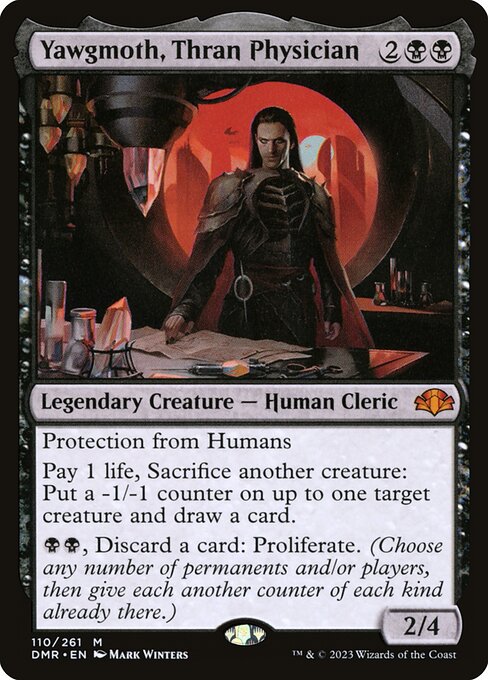
Aside from this minor but crucial advantage, the advent of Booster Fun meant a seismic change in how we view the desirability of cards. It used to be that foils were vanishingly rare and thus extremely expensive compared to the nonfoil versions. Look at the disparity between the prices of post-Urza/pre-Modern foils versus their nonfoil equivalents. Now, you can get foils of multi-format staples for almost the same price as the nonfoil version—a foil Ledger Shredder is only a couple of dollars more than your bog-standard Ledger Shredder.
There’s some grumbling that Wizards has reduced the excitement of opening foils in draft boosters to push players to the more expensive boosters, and I get that; but as someone who wants to play the game and sees opening boosters as a side benefit, the Booster Fun/Secret Lair era has been great to me. I can buy the more expensive borderless/alt art cards I need for my favorite decks and snag the cheapest versions of everything else I need.
Double Masters 2022 is another statement of purpose in the Reprint Everything Not Reserved Era, and I’ve been catching the cards as they plummet. There’s something marine scientists know as whale fall, where the sinking corpse of a whale creates its own micro-ecology, with scavengers picking the flesh, the scraps nurturing the rich silt, and the skeleton providing a kind of pseudo-reef. That maps to Magic as well: the whales turn their crypto windfalls or six-figure incomes into Collector’s Boosters, and I snipe the scraps off Card Kingdom and eBay. Let people bust packs and hunt for Cavern of Souls and Dockside Extortionist and Phyrexian Altar, and I’ll buy $10 of Deathbringer Lieges that I’ll eventually buy list for $27.
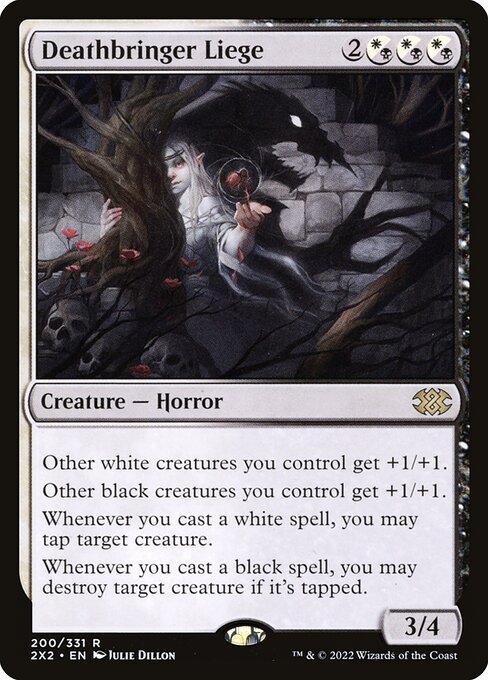
It’s not glamorous, but it is always a delight to convert a stack of cards from several years ago into a recently-reprinted staple. So let’s dive deep and see what’s sinking to the bottom—but, unlike in the benthic deeps, isn’t likely to remain at the bottom.
The big hits for Double Masters are obvious. They’re the cards that get a high-five when opened, the ones that Wizards used to sell the set during its preorder period. It’s always nice to see cards like Mana Vault, Dockside Extortionist, and Imperial Seal get reprinted, but that’s not our focus today. I remember the first Modern Masters set back in 2013, and how the move was buying five dollar Tooth and Nail and throw-in Scion of Oona.
That said, the willingness to reprint Imperial Seal and Warrior’s Oath and Food Chain is an interesting statement. Aside from bolstering the perceived value of the set and locking in sales, it demonstrates that Wizards is tracking competitive EDH, where Seal is one of the top tutors and Food Chain is a critical combo piece. I can’t recommend buying these at their current price unless you play cEDH, but Imperial Seal’s price has already been slashed to a fraction of its recent value and I doubt it’s done falling. Compare to Grim Tutor, which presold for an absurd eighty dollars before falling to twelve. This is a premium set, of course, so I don’t expect a similar trajectory, but I do expect this to be the first of several reprints for the Three Kingdoms tutor.
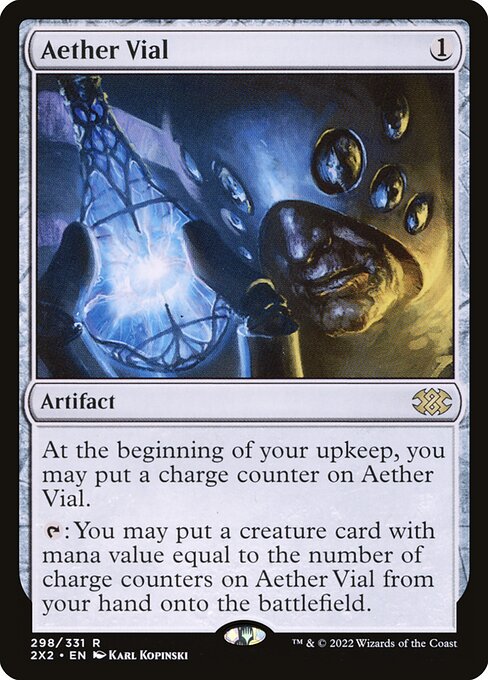
My favorite financial picks are cards whose price was elevated by tournament play—the Commander players hunting for Mana Vaults don’t value them, and an influx of new copies means the price falls more quickly than cards that see Commander play. A year ago, Surgical Extraction was $45-50; now, you can buy a borderless copy with splashy new Thomas M. Baxa art for $15 (or a regular one for under eight bucks). Aether Vial is now $50-60 a playset, instead of a copy, and the Tarkir Commands are going to be pulverized by this reprint.
These are blue chip stocks, who will sink in price and then, gradually but predictably, rise as copies filter out of the market into players’ sideboards. Wizards is not likely to ever print an Extraction effect better than Surgical, and Aether Vial has shaken off reprints in the past and remains the best way to cheat out cheap creatures under countermagic (or for free to be backed up with your own countermagic). If you travel to tournaments, you can fund your participation by buying these cards long before the event and selling to vendors who are seeking playable tournament cards for their hotlist.
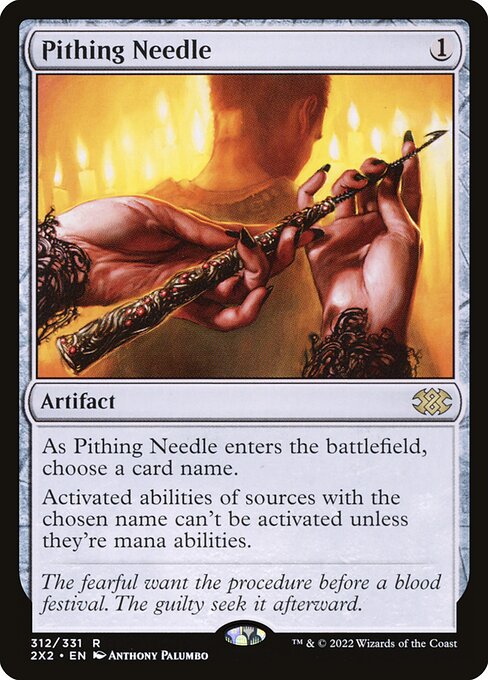
Borderless Foil Pithing Needle: Speaking of perpetual sideboard staples, Pithing Needle got an upgrade in Double Masters, with gaudy and glorious new Ron Spencer art. Pithing Needle has hit rock-bottom since receiving a nail-in-the-coffin reprint in Midnight Hunt, and I think that’s skewed the pricing on the borderless foil. You can snag these for $6-8 right now. While Modern has evolved since Pithing Needle was closer to a dagger, this is still a staple and still fetchable off Urza’s Saga, so I picked up a set.
Borderless Foil Wall of Omens: Right now, borderless foil Wall of Omens are going for $2-3. I don’t suggest going all in, but it’s a stunning card in person, and sees enough Commander play to be worthwhile as a cheap pick. In fact, all of the common/uncommon borderless cards are great pickups—while they won’t ever fund your retirement, you can get Seeker of the Way, bouncelands, Thought Scour, and Monastery Swiftspear for under a buck, and Inquisition of Kozilek for a couple dollars.
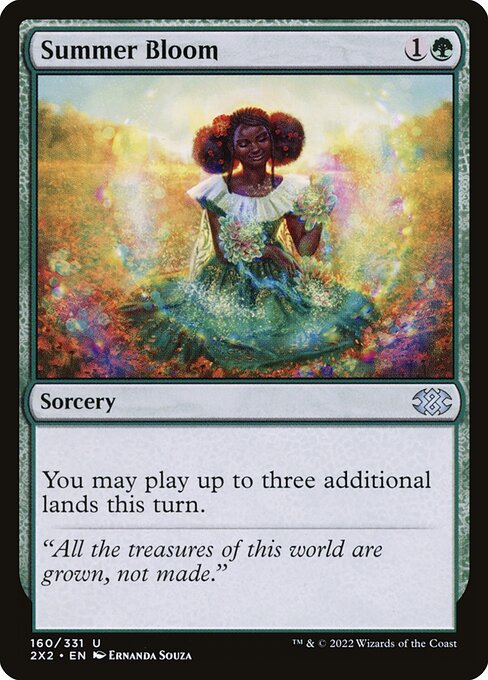
Foil Summer Bloom: This is the art pick. At uncommon, there will be a huge influx of Summer Blooms, which will crush the price of an omnipresent but single-deck card. That said, Ernanda Souza’s art is stunning, with an overload of lush color balanced out by a crisp composition (the way the background frames the central figure!) and a gauzy overwash. The foils have a mild and throwback-y premium—the nonfoil is $.50 and the foils $3—which bodes well for its growth in the future. Keeping a stack of these should pay off.
Foil Coldsteel Heart: Speaking of unaffordable uncommon foils, Coldsnap was a long time ago and a poorly-received set, so Coldsteel Heart has been overpriced as a foil due to scarcity, with the card floating around $25-30 for years. Double Masters foil Coldsteel Heart is still a bit pricey for an uncommon, which, as with Summer Bloom, suggests opportunities in the future—notably, it’s also the first printing with the Kaldheim frosty text box, and Modern’s premier Snow mana-producer since we lost Astrolabe. Add Commander play and we have a card with the pedigree to rise again. I’m waiting until it hits two bucks, but I have a stack ready to go when it does.
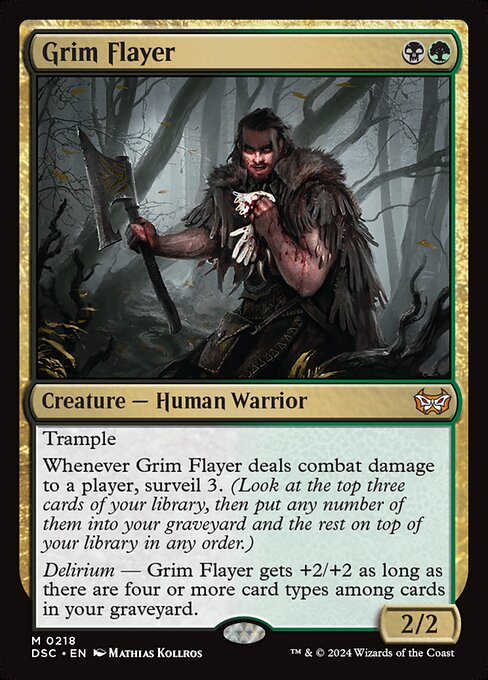
Grim Flayer: And here’s the Rob pick. I’ve been trying to make Grim Flayer work in Pioneer for the last few weeks in both Jund Delirium and Sultai decks, as Red gets you Fable of the Mirror-Breaker and Kolaghan’s Command and Sultai gives you access to Ledger Shredder. I don’t have a list I’m happy with yet, but you can get a foil playset of borderless, Richard Kane Ferguson-painted Flayers for $12 right now. As Liliana, the Last Hope also loses value, it becomes easier to justify a Delirium build, so watch this space for more on the deck.
These prices are in flux right now, of course. We’re still in the first week of Double Masters, and many folks still haven’t gotten their boxes at all, let alone busted them and listed the chaff on clearinghouse sites. I have my eye on several higher-value cards for personal play—borderless foil Smothering Tithe, which is slowly deflating below fifty bucks, and borderless Damnation, which has been reprinted three times in the last eighteen months and has absolutely stunning new Ian Miller art.

In reviewing the set, I’m taken aback by how dedicated Wizards was in Double Masters to reprinting staples in almost every format, from Legacy’s Food Chain to cEDH’s Imperial Seal to Commander’s Smothering Tithe to Modern’s Surgical Extraction and Aether Vial. The Eldrazi Titans, niche cards like Warrior’s Oath, underprinted retro cards like Concordant Crossroads—the list goes on and ameliorates the sting of the Commander exclusives and guaranteed-to-hit-$.50 cards. If, as I would argue, the success of Masters sets is in producing decks that are a) cheaper to acquire and b) more aesthetically beautiful, then Double Masters 2022 is an unqualified success.
A lifelong resident of the Carolinas and a graduate of the University of North Carolina, Rob has played Magic since he picked a Darkling Stalker up off the soccer field at summer camp. He works for nonprofits as an educational strategies developer and, in his off-hours, enjoys writing fiction, playing games, and exploring new beers.

